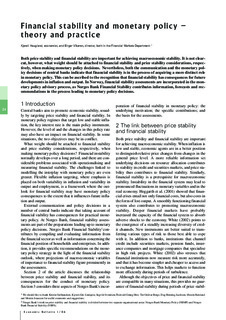Financial Stability and Monetary Policy - Theory and Practice
| dc.contributor.author | Haugland, Kjersti | |
| dc.contributor.author | Vikøren, Birger | |
| dc.date.accessioned | 2018-07-04T10:26:23Z | |
| dc.date.available | 2018-07-04T10:26:23Z | |
| dc.date.issued | 2006 | |
| dc.identifier.issn | 0029-1676 | |
| dc.identifier.uri | http://hdl.handle.net/11250/2504306 | |
| dc.description.abstract | Both price stability and financial stability are important for achieving macroeconomic stability. It is not clearcut, however, what weight should be attached to financial stability and price stability considerations, respectively, when making monetary policy decisions. Nevertheless, both the communication and the monetary policy decisions of central banks indicate that financial stability is in the process of acquiring a more distinct role in monetary policy. This can be ascribed to the recognition that financial stability has consequences for future developments in inflation and output. In Norway, financial stability assessments are incorporated in the monetary policy advisory process, as Norges Bank Financial Stability contributes information, forecasts and recommendations in the process leading to monetary policy decisions. | nb_NO |
| dc.language.iso | eng | nb_NO |
| dc.publisher | Norges Bank | nb_NO |
| dc.rights | Attribution-NonCommercial-NoDerivatives 4.0 Internasjonal | * |
| dc.rights.uri | http://creativecommons.org/licenses/by-nc-nd/4.0/deed.no | * |
| dc.title | Financial Stability and Monetary Policy - Theory and Practice | nb_NO |
| dc.type | Journal article | nb_NO |
| dc.subject.nsi | VDP::Samfunnsvitenskap: 200::Økonomi: 210::Samfunnsøkonomi: 212 | nb_NO |
| dc.source.pagenumber | 24-31 | nb_NO |
| dc.source.journal | Economic Bulletin | nb_NO |
| dc.source.issue | 1/2006 | nb_NO |
Tilhørende fil(er)
Denne innførselen finnes i følgende samling(er)
-
Penger og Kreditt / Economic Bulletin [473]
1973 (1999)-2012

